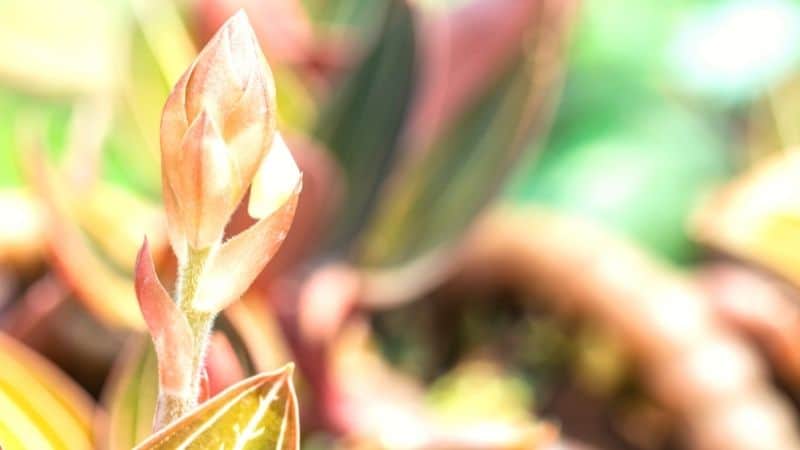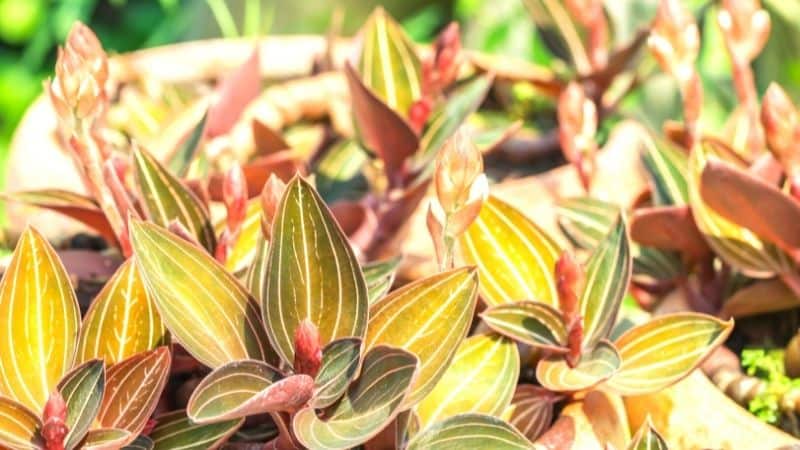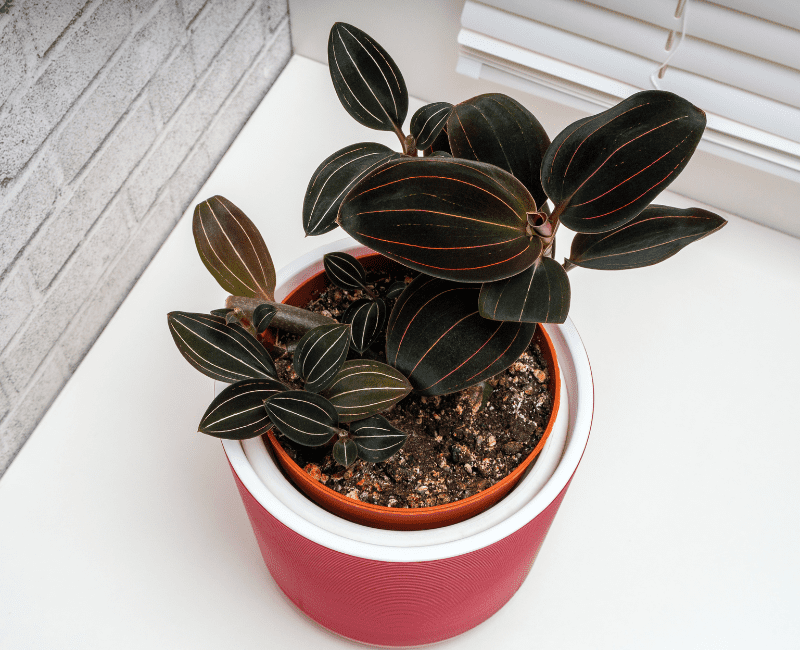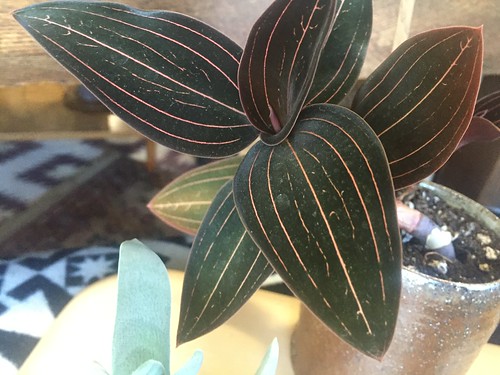The Jewel Orchid is characterized by its unique foliage which is a velvety deep maroon color with red arterial veins that run parallel with the central spine of the leaf.
Jewel Orchids prefer warm, tropical climates and can be found in some countries that line the equatorial zone. Besides their striking purple foliage, they grow small white flowers which often have yellow curling petals forming a focal center point of the flower.
Jewel Orchid Care Guide Overview
- How To Plant (when & where)
- How To Grow (staking, watering, fertilizing, humidity, mulching)
- How To Trim And Prune
- How To Pot And Repot
- How To Propagate (when & how)
- And Pests and Diseases, Plant Species, Companions, Toxicity
Characteristics
- Scientifc Name: Ludisia discolor
- Common Name: Jewel Orchid
- Origin: China, Northeast India, Thailand, Vietnam, the Philippines, Malaysia, Indonesia, and Myanma
- Indoor/Outdoor Plant: Common indoor houseplant. Grows well outdoors in native environments
- Height; Structure: 6-12 inches tall, 12 inches wide when grown as a houseplant. Flower spikes of up to 24 inches high.
- Temperature: Ideally a minimum of 61°F (16°C) and a maximum of 80°F (27°C)
- Flower Color: White with a central yellow petal accent
How To Plant Jewel Orchids

Jewel Orchids are excellent houseplants and require very little maintenance throughout their life. They are terrestrial orchids that prefer warm, humid conditions, and do not require a lot of direct sunlight to thrive. In their natural environment, Jewel Orchids are found on the forest floor where they enjoy a steady humid temperature and moist conditions. However, Jewel Orchids thrive in a range of temperature conditions.
Planting Time
These orchids prefer warm, humid climates so planting time is ideal when the weather is warm. Due to their size and slow growth rate, they will not usually require repotting more than once a year if given a pot of around 6-8 inches in diameter. A wide, shallow growing pot of 8 inches is perfect.
Spacing
Jewel Orchids are not too fussy when it comes to spacing and only require enough space for their stunning foliage to grow, so allow around 6-8 inches.
They will happily grow amongst other varieties of orchids, and when potted with other species of orchids, allow around 12-15 inches from stem to stem. This will also allow each plant to gather enough nutrients from the soil without interfering with one another.
The correct spacing will allow the beautiful foliage of the orchid enough room to grow and spread out, cascading from their stem. Their terrestrial roots will also require around 8 inches of space to spread out.
Light requirements
Jewel Orchids thrive in low to medium levels of diffuse light. If planting outdoors, avoid areas that receive full sun as it will scorch the leaves, causing them to yellow or go brown.
When potted indoors, keep them away from windows that receive direct sunlight. They grow exceptionally well in the middle of a room or by north-facing windows that receive enough diffuse light throughout the day. They are extremely tolerant to low light levels, so potting them on a coffee table away from the full sun is ideal.
The best way to check if your Jewel Orchid isn’t getting too much sun is by placing your hand over the orchid; if it creates a strong shadow, that’s too much light and your plant should be moved to a location with more diffuse light.
If you live in an area with very low sunlight levels during winter, supplement natural light by using LED grow lights at medium intensity for around 12 hours each day. Grow light sets are available online or at any decent garden store.
Soil
Unlike many other varieties of orchids, Jewel Orchids require soil to grow due to their terrestrial roots. The type of soil and moisture content of the soil is also very important. Jewel Orchids prefer bone-dry soil and should always be potted using a specialized orchid soil mix.
A dense soil mix consisting of 50% peat moss and 50% perlite works best, as the perlite acts as a ‘filler’ and promotes airflow within the soil.
A slightly less dense soil option that is also preferred by Jewel Orchids is soil containing a mix of 20% bark, 50% sphagnum moss, and 30% perlite. This is ideal for areas that are less humid, although you will need to increase watering to compensate.
Another good way to ensure your Jewel Orchid lives a healthy and happy life is to use a layered substrate soil arrangement. When layering different soil types, always use gravel or substrate that has good drainage properties. A top layer of sphagnum moss then a layer of bark or perlite mix works well.
How To Grow Jewel Orchids

Growth habits
Due to their striking large leaves, Jewel Orchids tend to spread out more than aiming to grow tall. The leaves will concentrate around the lower third of the plant, with long sinewy stems protruding from the foliage that grows the slender and elegant white flowers.
Staking
You shouldn’t need to stake your Jewel Orchid, and if you notice that its leaves or stems are drooping, it is likely due to overwatering or soil conditions that are too damp.
If you want to train a stem with a stake, use a strong thin plastic training stake and carefully insert it into the soil. Be very careful not to puncture any of the roots as this will damage your orchid.
Use a thin plastic-coated wire to softly attach the stem to the training stake. Do not overtighten or strangle the orchid stem, and as a rule of thumb, allow around a ¼ inch gap (or your pinky finger) between the wire and the stem of the orchid.
Watering
Jewel Orchids require very little watering and it’s easy to overwater them. Your Jewel Orchid should display firm green roots when it is receiving the ideal amount of water. If the roots appear dark green or soft, that’s a sign of overwatering. If the roots appear dull and white, then more regular watering is required.
Ice cubes are a great way to provide enough water for your orchid. Depending on the season and where your orchid is located, simply place 1 medium-sized ice cube on your orchid substrate every 3-4 days.
Another method for watering your orchid is to occasionally submerge your orchid root system in clean distilled water. To do this you should pot your orchid in a clear plastic container that slides into its external container. Fill the clear container to the crown of the roots. Allow the orchid to soak for around 15 minutes.
Once soaked, allow it to drain and remove any excess water, then place your orchid back into the external pot. Do this once a week during the summer months and once every 2-3 weeks during the winter.
If using a watering can, a ¼ cup of water each week evenly distributed around the base of the orchid roots is ideal during summer, and around every 2-3 weeks in the cooler months.
Fertilizing
Jewel Orchids should be fed a balanced diluted liquid fertilizer mix. An orchid fertilizer with an N-P-K ratio of 20-20-20 is ideal for providing the nutrients that a terrestrial orchid needs.
Feed your orchid once a fortnight during spring and summer and once a month during fall and winter. It is always best to fertilize your Jewel Orchid immediately after soaking the root system or watering as this will allow the fertilizer to be absorbed into the top substrate (bark) without overwhelming the root system.
Humidity
Warm, moderate humid conditions of around 60-70% will mimic the Jewel Orchids’ natural habitat and will always yield the best results. Avoid keeping them in areas with a draft, and avoid exposing them to frost.
Jewel Orchids are also sensitive to dramatic temperature fluctuations. Orchids are very sensitive to frost and should never be potted in a space below 60°F for a prolonged period of time. Ideal nighttime temperatures for jewel orchids are between 61°F (16°C) – 78°F (25°C) and daytime temperatures of 75°F (24°C) – 80°F (27°C).
Mulching
Mulch with a composted hardwood bark. Alternatively use sphagnum moss as a top layer and this will allow a good amount of water retention around the root crown.
Trimming And Pruning
It is rarely necessary to prune your Jewel Orchid. It is no problem to trim off the budding stems before they flower if you prefer the look of the orchid without the long slender stems and white flowers.
Another time you may want to trim your orchid is when you are dividing it. This should be done during the spring and is done by carefully trimming the roots to halve the size of the orchid.
Dividing your Jewel Orchid into smaller divisions is also fine and a small root-only cutting can be taken and propagated by placing the cutting in water until it sprouts roots.
Pot And Repotting
Repot your orchid once a year to provide your orchid with fresh nutrients from the soil. This also removes the likelihood of diseases or parasite buildup in the soil. You shouldn’t need to repot your orchid more than once a year. However, it’s worth repotting whenever you notice any of the following symptoms:
- Root rot
- Leaves turning red or yellow
- Leaves drooping or falling off
- Roots creeping outside of the pot
- Irregular flowering or flowers not opening
When repotting the Jewel Orchid, avoid doing this during the wintertime as it may stress the plant. Orchids are very susceptible to cold winds and frost so the best time for repotting is when the weather is warm and slightly humid.
If you’re repotting your orchid amongst plant neighbors, make sure you give them enough space to grow and stretch out in the container. Crowding orchids will cause stress, which in turn, can lead to your orchid contracting diseases.
Jewel Orchid Propagation

The best time to propagate your orchid is during the springtime. Cut a stem into small pieces, each with 2 dormant buds per stem. They’ll root easily in a slightly moist potting medium.
Another method is taking a cutting of the stem and putting it into some water until roots start to sprout. This usually takes a few months so be sure to change the water regularly, at least 2-3 times per week.
Pests And Diseases
The most common disease that Jewel Orchids experience is root rot, which occurs due to overwatering or being placed in a cool damp environment.
Another common disease caused due to excessive moisture or high humidity levels is Botrytis Blight. This appears as a fluffy gray mold that usually concentrates around the root crown.
Anthracnose ; Leaf Spot Disease is another disease to look out for on your Jewel Orchid. It resembles yellowish spots that form on the leaves and is caused by poor air circulation, excessive humidity, or overwatering.
Jewel Orchids will also occasionally be affected by pests such as mealybugs, mites, scale insects, whiteflies, spider mites, or aphids. Use a natural neem oil pesticide to remove any outbreaks of pests on your orchid.
Jewel Orchid Varieties


Jewel Orchids are a genus of orchids that contains only two direct species: the Ludisia discolor, and the Ludisia ravanii which is found only in the Philippines.
There are two notable cultivars of the Ludisia discolor species:
- L. discolor ‘Alba’, a striking albino variant.
This rare orchid variant is characterized by having intense green leaves with pale yellow veins highlighting the leaves. They are ideal for low light or partial light settings and grow well indoors.
- L. discolor ‘Nigrescens’, often referred to as “black velvet”.
Similar to the primary species Ludisia discolor, this plant has striking dark green leaves that can often be hues of deep maroon. They have arterial veins that are colored somewhere between a pale white or light yellow color.
Some plants have different vein highlight colors and it is common to find this species with metallic silver, grayish-white, pink, and dark red veining. L. discolor ‘Nigrescens’ are a great starter plant for a hobbyist or plant enthusiast. They grow faster and can tolerate a greater temperature range compared to other varieties of Jewel orchids.
Companions
Jewel Orchids are not fussy neighbors and only require decent potting soil and substrate to survive. Given their potting soil requirements, they pair well with other orchids.
When neighboring them with another plant, do not crowd your plants. Give them enough space to allow for the roots to extend and grow in all directions, and also consider that Jewel Orchids also need lots of space for their large leaves to hang.
Toxicity
Jewel Orchids are not considered toxic to humans, cats, or dogs, although when ingested in large quantities may cause vomiting or nausea.
Final Thoughts
Jewel Orchids make excellent houseplants because they are so easy to look after. If you follow these simple care instructions your orchid will thrive and you can enjoy this special plant for many years to come.


